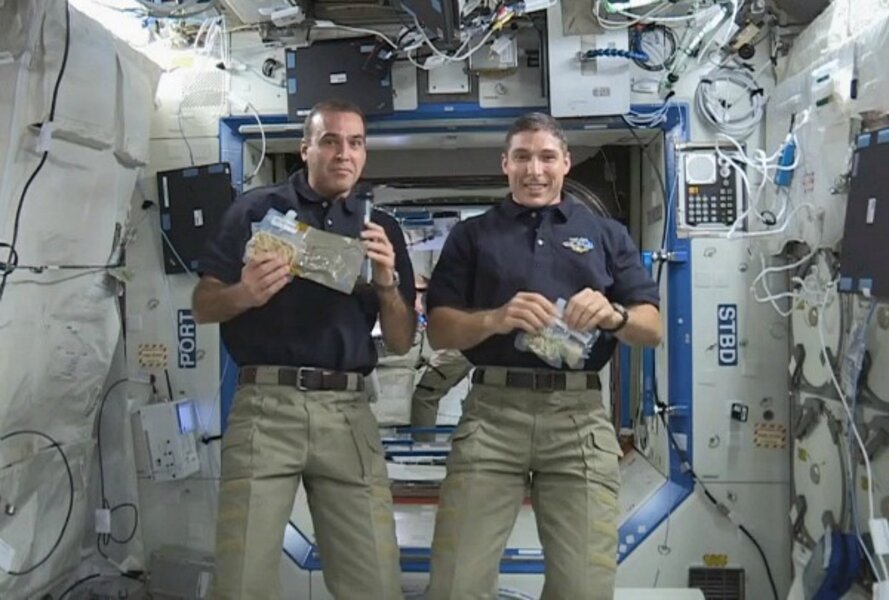Christmas Day spacewalk? Astronauts will go outside to fix space station.
Loading...
Three spacewalks over five days, with a final outing Christmas Day that ties the bow on a badly needed space-station repair job?
This might not have been the way NASA astronauts Rick Mastracchio and Air Force Col. Mike Hopkins originally planned to spend Christmas. But that's the schedule they face now that the agency has decided to replace a malfunctioning coolant pump on the station's exterior.
Mission managers made the call on Tuesday afternoon, determining that it was more prudent to replace the pump with one of three spare units the station carries than continue pursuing a work-around engineers had devised for bringing the pump back into full service.
The pump sends ammonia through one of two external cooling loops designed to remove heat from the station's interior as well as from equipment on the station's exterior.
On Dec. 11, ground controllers noticed that the fluid was too cool. Temperatures were sufficient to continue cooling equipment outside the station's modules. But the ammonia also circulates through a heat exchanger inside the station, accepting the excess heat from a water-based loop that keeps hardware, labs, and living spaces in the station cool.
Engineers isolated the problem to a flow-control valve used to regulate the ammonia's temperature and devised a way to use a different valve to do the job.
"The engineering teams did just an amazing job of sorting through all kinds of options to try to recover the valve and look at other ways to manage the flow," said Michael Suffredini, the International Space Station program manager.
But by late Tuesday, it still wasn't clear that that the fix would allow controllers to manage the coolant flow reliably – especially if the second exterior cooling system failed. Meanwhile, the station is heading into a period each year where its orbit exposes it to sunlight for virtually its entire path around Earth, raising the stakes if both external cooling systems don't work properly.
If the ISS team was to have enough time to prepare for the spacewalks and swap out pumps before the station entered this period, NASA officials had to make the call Tuesday.
"The better part of valor was to go ahead and pick a path," Mr. Suffredini said, and mission managers opted to replace the pump.
The two NASA astronauts are primed for the task, say mission managers.
Colonel Hopkins "is a rookie spacewalker, but very excited to go out the door," said Allison Bolinger, the station's lead spacewalk officer, during a briefing Wednesday. Mr. Mastracchio has six previous spacewalks to his credit and will serve as the spacewalk lead for the first two excursions.
Each spacewalk is expected to last about 6-1/2 hours. The first, on Dec. 21, involves disconnecting the balky pump, replacing it with jumpers that keep the cooling circuit closed, and preparing the spare pump for installation. On Day 2, Dec. 23, the duo will remove the old pump and stow it temporarily on a nearby platform, then move the new pump from its storage location, bolt it to its new location along the station's truss, and connect it to the station's electric grid. During the final spacewalk, Dec. 25, the two astronauts will reconnect the coolant lines, move the old unit to its permanent storage location, clean up the work site, and call it a Christmas.
Depending on how well the first two spacewalks go, it might be possible to squeeze all of the activities into two outings.
Mission planners have scheduled this job mindful of a mishap in July that allowed water to collect inside the helmet of Italian astronaut and Air Force Maj. Luca Parmitano two hours into a spacewalk. Water droplets leaked from the suit's cooling system and were delivered by cooling fan into the helmet.
Initially it pooled near the back of his head. But as he worked his way back to the airlock, the water broke up into droplets that spread throughout the helmet to clog his ears, prevent him from seeing clearly, and gather in his nose.
An investigation team is still trying to figure out what caused water to leak from the suit's cooling system into Major Parmitano's helmet. In the meantime, engineers have devised ways to warn an astronaut if water is collecting in the back of a helmet, said Ms. Bolinger.
As a first line of defense, she said, astronauts insert an absorbent pad on the back of the helmet. Just as spacewalking astronauts conduct leak checks on their gloves, they now will conduct "squishiness tests" on the pads, she said. The pads can absorb from 20 to 27 ounces of water. Tests on the ground show that astronauts can sense "squishiness" in the pad when it has only about 7 ounces of water in it. If a pad feels squishy, it's time to head back to the airlock.
In addition, engineers found a way to modify tubing used in a space suit's cooling system to serve as a snorkel. It runs down the front of the suit, allowing an astronaut to breath oxygen from near his or her midsection if water gathers in the helmet.
In the meantime, astronauts on the station have swapped out a fan and pump system in the suit Parmitano used and that appears to have provided the pathway for water to enter the helmet.
With that replacement, "we think that's an extremely clean suit and it's ready to go," said ISS flight director Dina Contella. Hopkins will be wearing the suit.








